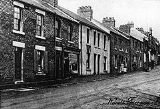
Murton, County Durham
Encyclopedia
Murton is a village in County Durham
, England
. Lying six miles (9.6 km) east of the city of Durham
and seven miles (11.25 km) south of Sunderland, it has a population of 7,339.
Originally a rural agricultural hamlet called Morton, the discovery of coal beneath its fields in the 19th century transformed it into an industrial community. 'Morton became known as Murton Colliery or Murton-in-the-Whins following the sinking of the pit in 1838 by South Hetton Coal Company, and the village was a productive coal mining community for over a century. The pit employed over 1000 men at its peak and featured in a Picture Post
article showing the 'vesting' of the mine at nationalisation in 1947.
The village also had the South East Durham Cooperative Bakery and a Northern Bus Company garage as added sources of jobs. In 1955 a by product works for coal was established for the production mainly of coke
. The mine
and other employment opportunities closed in the 1990s along with many other County Durham
mines and now the old spoil heaps are host to a retail outlet development Dalton Park
, bringing much needed new employment.
during the 19th century, transformed the tiny hamlet of Morton into the thriving township of Murton.
Decades later, however, the decision to close Murton's successful colliery almost, but not quite, succeeded in turning the close-knit community into a ghost town. Millions of pounds in Government
and private investment is now being pumped into Murton, changing the face of the former pit village
on an almost daily basis.
Fewer than 100 people lived in the village of Murton before 1830 but, following the sinking of the mine in 1838, the population grew to 1,387 by 1851. Miner
s flocked to Murton from across County Durham
and Northumberland
in the early years, with people later uprooting from Devon
, Cornwall
and Ireland
too. Many of the road and place names reflected the original roots of these pitmen, like the Cornwall
estate, and dozens of different accents could be heard in the streets.
Work on the colliery – one of the pioneering mines of the East Durham coalfield, began on February 19, 1838, but it was five years before the first coals were drawn. Problems with pockets of shifting sand and the depth of the magnesium limestone overlying the coal delayed the work, making the project hugely expensive. Late shifts were even introduced for the first time, so that excavation could be carried out around the clock to finish the three-shafted pit as quickly as possible.
Just five years after the colliery opened, however, there was an explosion on August 15, 1848, near the Polka East shaft, which killed 14 miners. The tragedy left villagers shaken, but the village itself continued to flourish. Indeed, by 1856 Murton was almost unrecognisable from the hamlet
it had once been. Scores of terraced houses had been built to house the miners and the village
now boasted three pubs, a new school, plus gas and coke works. As prospective miners continued to flood in, so the number of tradesmen grew, with Murton Colliery Co-operative Society helping to serve the village by 1890.
As the village flourished, so too did the colliery. It was modernised after World War I
and, in 1922, a Koepe friction winding engine was installed in the West Pit. New pithead baths followed in 1939, described as being "of especially pleasant design," and Murtons swimming pool was opened in 1961.
But, despite high productivity and a loyal workforce, the decision was taken to close the pit in 1991. Campaigners fought against the plans, but failed to stop them. The Koepe winding engine was transferred to the Bowes Railway
following the controversial closure and, in 1994, the colliery's winding tower was demolished. Murton's once-thriving pit community was now no more.
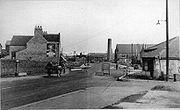
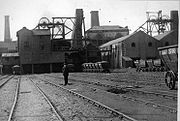
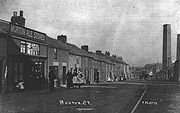
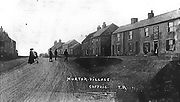 1830: Population
1830: Population
69
1838: Work on pit
starts
1843: First coal
s drawn
1851: Population
1,395
1889: Electricity
first used in pit
1892: Murton
toll gates removed
1902: Three putters killed in pit, two aged 14, one aged 18
1906: Colliery draws 4,131 tons of coal in one day
1910: Miners strike over Eight Hours Bill
1913: Foundation stone laid for first council house
1914: First public telephone
for Murton, based in post office
1922: Cenotaph
unveiled
1923: Coal drawn from West Pit for first time
1927: Bus service to Sunderland introduced by Northern buses
1930: First "talking pictures" at Murton Empire
1931: Flush toilets put in colliery houses
1935: Miners started carrying electric lamps
1939: Pit head baths opened
1950: X-ray
van visited Murton for the first time
1953: The first paid annual holiday leave of two weeks was introduced
1957: A new library
was opened in Barnes Road
1958: Murton Brickworks closed
1961: Murton's swimming pool was opened
1982: First memorial service held to commemorate fatalities at Murton pit
1990: Miners fought to keep the pit open
1991: Murton Colliery was closed
1994: Pit winding tower demolished, despite being listed
, Murton has a temperate
climate. At 643.3 millimetres (25 in) the average annual rainfall is lower than the national average of 1125 millimetres (44 in). Equally there are only around 121.3 days where more than 1 millimetre (0.0393700787401575 in) of rain falls compared with a national average of 154.4 days. The area sees on average 1374.6 hours of sunshine per year, compared with a national average of 1125.0 hours. There is frost on 52 days compared with a national average of 55.6 days. Average daily maximum and minimum temperatures are 12.5 °C (54.5 °F) and 5.2 °C (41.4 °F) compared with a national averages of 12.1 °C (53.8 °F) and 5.1 °C (41.2 °F) respectively.
The table below gives the average temperature and rainfall figures taken between 1971 and 2000 at the Met Office weather station in Durham:
Lancaster Street: Double Rar
Green Street: Smokey Rar
Railway Street: Red Tiled Rar
Villiers Street: Wood Rar
Durham Place: Sinkers Rar
Dalton Terrace: Pot Pie Rar
South Street: Plantation Rar
East Street: Cinder Burners Rar
Shipperdon Street: Ower the Field
Murton Street: Cross Rar
Old Pilgrim Street: Boiler Rar
New Pilgrim Street: Low Rar
Pilgrim Street: High Rar
Model Street: Wagon Rar
County Durham
County Durham is a ceremonial county and unitary district in north east England. The county town is Durham. The largest settlement in the ceremonial county is the town of Darlington...
, England
England
England is a country that is part of the United Kingdom. It shares land borders with Scotland to the north and Wales to the west; the Irish Sea is to the north west, the Celtic Sea to the south west, with the North Sea to the east and the English Channel to the south separating it from continental...
. Lying six miles (9.6 km) east of the city of Durham
Durham
Durham is a city in north east England. It is within the County Durham local government district, and is the county town of the larger ceremonial county...
and seven miles (11.25 km) south of Sunderland, it has a population of 7,339.
Originally a rural agricultural hamlet called Morton, the discovery of coal beneath its fields in the 19th century transformed it into an industrial community. 'Morton became known as Murton Colliery or Murton-in-the-Whins following the sinking of the pit in 1838 by South Hetton Coal Company, and the village was a productive coal mining community for over a century. The pit employed over 1000 men at its peak and featured in a Picture Post
Picture Post
Picture Post was a prominent photojournalistic magazine published in the United Kingdom from 1938 to 1957. It is considered a pioneering example of photojournalism and was an immediate success, selling 1,700,000 copies a week after only two months...
article showing the 'vesting' of the mine at nationalisation in 1947.
The village also had the South East Durham Cooperative Bakery and a Northern Bus Company garage as added sources of jobs. In 1955 a by product works for coal was established for the production mainly of coke
Coke (fuel)
Coke is the solid carbonaceous material derived from destructive distillation of low-ash, low-sulfur bituminous coal. Cokes from coal are grey, hard, and porous. While coke can be formed naturally, the commonly used form is man-made.- History :...
. The mine
Mining
Mining is the extraction of valuable minerals or other geological materials from the earth, from an ore body, vein or seam. The term also includes the removal of soil. Materials recovered by mining include base metals, precious metals, iron, uranium, coal, diamonds, limestone, oil shale, rock...
and other employment opportunities closed in the 1990s along with many other County Durham
County Durham
County Durham is a ceremonial county and unitary district in north east England. The county town is Durham. The largest settlement in the ceremonial county is the town of Darlington...
mines and now the old spoil heaps are host to a retail outlet development Dalton Park
Dalton Park
Dalton Park is a shopping centre in Murton, County Durham. It is built on the site of the former colliery's slag heaps. It is the largest factory outlet style shopping centre in the North East, where branded goods are sold at discounted prices, usually discontinued lines of stock...
, bringing much needed new employment.
History
The discovery of coal beneath the fields of East DurhamDurham
Durham is a city in north east England. It is within the County Durham local government district, and is the county town of the larger ceremonial county...
during the 19th century, transformed the tiny hamlet of Morton into the thriving township of Murton.
Decades later, however, the decision to close Murton's successful colliery almost, but not quite, succeeded in turning the close-knit community into a ghost town. Millions of pounds in Government
Government
Government refers to the legislators, administrators, and arbitrators in the administrative bureaucracy who control a state at a given time, and to the system of government by which they are organized...
and private investment is now being pumped into Murton, changing the face of the former pit village
Pit village
A pit village is a term used in the UK for the village serving a deep coal mine.Many of the workers lived in houses that were provided by the colliery. Many villages have experienced depopulation after colliery closures forced people to move to other towns and cities where there are jobs for them...
on an almost daily basis.
Fewer than 100 people lived in the village of Murton before 1830 but, following the sinking of the mine in 1838, the population grew to 1,387 by 1851. Miner
Miner
A miner is a person whose work or business is to extract ore or minerals from the earth. Mining is one of the most dangerous trades in the world. In some countries miners lack social guarantees and in case of injury may be left to cope without assistance....
s flocked to Murton from across County Durham
County Durham
County Durham is a ceremonial county and unitary district in north east England. The county town is Durham. The largest settlement in the ceremonial county is the town of Darlington...
and Northumberland
Northumberland
Northumberland is the northernmost ceremonial county and a unitary district in North East England. For Eurostat purposes Northumberland is a NUTS 3 region and is one of three boroughs or unitary districts that comprise the "Northumberland and Tyne and Wear" NUTS 2 region...
in the early years, with people later uprooting from Devon
Devon
Devon is a large county in southwestern England. The county is sometimes referred to as Devonshire, although the term is rarely used inside the county itself as the county has never been officially "shired", it often indicates a traditional or historical context.The county shares borders with...
, Cornwall
Cornwall
Cornwall is a unitary authority and ceremonial county of England, within the United Kingdom. It is bordered to the north and west by the Celtic Sea, to the south by the English Channel, and to the east by the county of Devon, over the River Tamar. Cornwall has a population of , and covers an area of...
and Ireland
Ireland
Ireland is an island to the northwest of continental Europe. It is the third-largest island in Europe and the twentieth-largest island on Earth...
too. Many of the road and place names reflected the original roots of these pitmen, like the Cornwall
Cornwall
Cornwall is a unitary authority and ceremonial county of England, within the United Kingdom. It is bordered to the north and west by the Celtic Sea, to the south by the English Channel, and to the east by the county of Devon, over the River Tamar. Cornwall has a population of , and covers an area of...
estate, and dozens of different accents could be heard in the streets.
Work on the colliery – one of the pioneering mines of the East Durham coalfield, began on February 19, 1838, but it was five years before the first coals were drawn. Problems with pockets of shifting sand and the depth of the magnesium limestone overlying the coal delayed the work, making the project hugely expensive. Late shifts were even introduced for the first time, so that excavation could be carried out around the clock to finish the three-shafted pit as quickly as possible.
Just five years after the colliery opened, however, there was an explosion on August 15, 1848, near the Polka East shaft, which killed 14 miners. The tragedy left villagers shaken, but the village itself continued to flourish. Indeed, by 1856 Murton was almost unrecognisable from the hamlet
Hamlet
The Tragical History of Hamlet, Prince of Denmark, or more simply Hamlet, is a tragedy by William Shakespeare, believed to have been written between 1599 and 1601...
it had once been. Scores of terraced houses had been built to house the miners and the village
Village
A village is a clustered human settlement or community, larger than a hamlet with the population ranging from a few hundred to a few thousand , Though often located in rural areas, the term urban village is also applied to certain urban neighbourhoods, such as the West Village in Manhattan, New...
now boasted three pubs, a new school, plus gas and coke works. As prospective miners continued to flood in, so the number of tradesmen grew, with Murton Colliery Co-operative Society helping to serve the village by 1890.
As the village flourished, so too did the colliery. It was modernised after World War I
World War I
World War I , which was predominantly called the World War or the Great War from its occurrence until 1939, and the First World War or World War I thereafter, was a major war centred in Europe that began on 28 July 1914 and lasted until 11 November 1918...
and, in 1922, a Koepe friction winding engine was installed in the West Pit. New pithead baths followed in 1939, described as being "of especially pleasant design," and Murtons swimming pool was opened in 1961.
But, despite high productivity and a loyal workforce, the decision was taken to close the pit in 1991. Campaigners fought against the plans, but failed to stop them. The Koepe winding engine was transferred to the Bowes Railway
Bowes Railway
The Bowes Railway, built by George Stephenson in 1826, is the world's only preserved operational standard gauge cable railway system. It was built to transport coal from Durham pits to boats on the River Tyne. Only part of the system now remains.-Background:...
following the controversial closure and, in 1994, the colliery's winding tower was demolished. Murton's once-thriving pit community was now no more.
Timeline




Population
A population is all the organisms that both belong to the same group or species and live in the same geographical area. The area that is used to define a sexual population is such that inter-breeding is possible between any pair within the area and more probable than cross-breeding with individuals...
69
1838: Work on pit
Open-pit mining
Open-pit mining or opencast mining refers to a method of extracting rock or minerals from the earth by their removal from an open pit or borrow....
starts
1843: First coal
Coal
Coal is a combustible black or brownish-black sedimentary rock usually occurring in rock strata in layers or veins called coal beds or coal seams. The harder forms, such as anthracite coal, can be regarded as metamorphic rock because of later exposure to elevated temperature and pressure...
s drawn
1851: Population
Population
A population is all the organisms that both belong to the same group or species and live in the same geographical area. The area that is used to define a sexual population is such that inter-breeding is possible between any pair within the area and more probable than cross-breeding with individuals...
1,395
1889: Electricity
Electricity
Electricity is a general term encompassing a variety of phenomena resulting from the presence and flow of electric charge. These include many easily recognizable phenomena, such as lightning, static electricity, and the flow of electrical current in an electrical wire...
first used in pit
1892: Murton
Murton
-Places:*Murton, Cumbria, England*Murton, County Durham, England*Murton, Northumberland, England*Murton, Tyne and Wear, England*Murton, Swansea, Wales*Murton, York, England-People:*Matt Murton...
toll gates removed
1902: Three putters killed in pit, two aged 14, one aged 18
1906: Colliery draws 4,131 tons of coal in one day
1910: Miners strike over Eight Hours Bill
1913: Foundation stone laid for first council house
1914: First public telephone
Payphone
A payphone or pay phone is a public telephone, often located in a phone booth or a privacy hood, with pre-payment by inserting money , a credit or debit card, or a telephone card....
for Murton, based in post office
1922: Cenotaph
Cenotaph
A cenotaph is an "empty tomb" or a monument erected in honour of a person or group of people whose remains are elsewhere. It can also be the initial tomb for a person who has since been interred elsewhere. The word derives from the Greek κενοτάφιον = kenotaphion...
unveiled
1923: Coal drawn from West Pit for first time
1927: Bus service to Sunderland introduced by Northern buses
1930: First "talking pictures" at Murton Empire
1931: Flush toilets put in colliery houses
1935: Miners started carrying electric lamps
1939: Pit head baths opened
1950: X-ray
X-ray
X-radiation is a form of electromagnetic radiation. X-rays have a wavelength in the range of 0.01 to 10 nanometers, corresponding to frequencies in the range 30 petahertz to 30 exahertz and energies in the range 120 eV to 120 keV. They are shorter in wavelength than UV rays and longer than gamma...
van visited Murton for the first time
1953: The first paid annual holiday leave of two weeks was introduced
1957: A new library
Library
In a traditional sense, a library is a large collection of books, and can refer to the place in which the collection is housed. Today, the term can refer to any collection, including digital sources, resources, and services...
was opened in Barnes Road
1958: Murton Brickworks closed
1961: Murton's swimming pool was opened
1982: First memorial service held to commemorate fatalities at Murton pit
1990: Miners fought to keep the pit open
1991: Murton Colliery was closed
1994: Pit winding tower demolished, despite being listed
Climate
Like the rest of the United KingdomUnited Kingdom
The United Kingdom of Great Britain and Northern IrelandIn the United Kingdom and Dependencies, other languages have been officially recognised as legitimate autochthonous languages under the European Charter for Regional or Minority Languages...
, Murton has a temperate
Temperate
In geography, temperate or tepid latitudes of the globe lie between the tropics and the polar circles. The changes in these regions between summer and winter are generally relatively moderate, rather than extreme hot or cold...
climate. At 643.3 millimetres (25 in) the average annual rainfall is lower than the national average of 1125 millimetres (44 in). Equally there are only around 121.3 days where more than 1 millimetre (0.0393700787401575 in) of rain falls compared with a national average of 154.4 days. The area sees on average 1374.6 hours of sunshine per year, compared with a national average of 1125.0 hours. There is frost on 52 days compared with a national average of 55.6 days. Average daily maximum and minimum temperatures are 12.5 °C (54.5 °F) and 5.2 °C (41.4 °F) compared with a national averages of 12.1 °C (53.8 °F) and 5.1 °C (41.2 °F) respectively.
The table below gives the average temperature and rainfall figures taken between 1971 and 2000 at the Met Office weather station in Durham:
Old village streets and their nicknames
Owen Street: Sandgate RarLancaster Street: Double Rar
Green Street: Smokey Rar
Railway Street: Red Tiled Rar
Villiers Street: Wood Rar
Durham Place: Sinkers Rar
Dalton Terrace: Pot Pie Rar
South Street: Plantation Rar
East Street: Cinder Burners Rar
Shipperdon Street: Ower the Field
Murton Street: Cross Rar
Old Pilgrim Street: Boiler Rar
New Pilgrim Street: Low Rar
Pilgrim Street: High Rar
Model Street: Wagon Rar
Economy
This is a chart of trend of regional gross value added of County Durham at current basic prices published (pp. 240-253) by Office for National Statistics with figures in millions of British Pounds Sterling.| Year | Regional Gross Value Added | Agriculture | Industry | Services |
|---|---|---|---|---|
| 1995 | 4,063 | 47 | 1,755 | 2,261 |
| 2000 | 4,783 | 40 | 1,840 | 2,904 |
| 2003 | 5,314 | 39 | 1,978 | 3,297 |
Notable inhabitants
- Ernest WilliamsonErnest WilliamsonErnest Clarke Williamson was an English football goalkeeper.Born in Murton, County Durham, Williamson began his career at local sides before moving to London in 1913 to join Croydon Common. During World War I he served in the Royal Army Service Corps and also turned out for various teams as a...
- Professional footballer - George LiddellGeorge LiddellGeorge M. Liddell was an English professional association football player and manager.-Biography:...
- Professional footballer and football club manager - James Hall DCM, MM - World War One soldier
- Joe Shaw (footballer born 1928) - Professional footballer
- John Cummings (politician) - Former miner, was MP for Easington until 2010
- Mary Ann CottonMary Ann CottonMary Ann Cotton was an English woman convicted of murdering her children and believed to have murdered up to 21 people, mainly by arsenic poisoning.-Early life:...
- First British female serial killer - Michael Murphy (VC)Michael Murphy (VC)Michael Murphy VC was an Irish recipient of the Victoria Cross , the highest award for gallantry in the face of the enemy that can be awarded to British and Commonwealth forces.Murphy was born circa 1837 in Cahir, Tipperary to Michael Murphy, a local blacksmith, and his...
- Won the Victoria Cross - Paul KitsonPaul KitsonFor the English footballer who spent most of his career in the United States, see Paul Kitson .Paul Kitson is an English former professional footballer who played as a striker...
- Professional footballer - William McNallyWilliam McNallyWilliam McNally VC, MM and Bar was an English recipient of the Victoria Cross, the highest and most prestigious award for gallantry in the face of the enemy that can be awarded to British and Commonwealth forces.-Details:...
- Won the Victoria Cross in World War One - Dave Harper - Drummer for pop group Frankie & The Heartstrings
See also
- DurhamDurhamDurham is a city in north east England. It is within the County Durham local government district, and is the county town of the larger ceremonial county...
- SeahamSeahamSeaham, formerly Seaham Harbour, is a small town in County Durham, situated south of Sunderland and east of Durham. It has a small parish church, St Mary the Virgin, with a late 7th century Anglo Saxon nave resembling the church at Escomb in many respects. St Mary the Virgin is regarded as one of...
- Durham Miners' GalaDurham Miners' GalaThe Durham Miners' Gala is a large annual gathering held on the second Saturday in July in the city of Durham, England. It is associated with the coal mining heritage of the Durham Coalfield, which stretched throughout the traditional County of Durham. It is also locally called "The Big Meeting"...
- Sunderland, Tyne and Wear
- DawdonDawdonDawdon is a former pit community to the south of Seaham, County Durham, in England. An area of the beach near Dawdon was used in the opening scenes of the film Alien 3.- History :...
- EasingtonEasington, County DurhamEasington is a town in eastern County Durham, England. It comprises the ancient village of Easington Village and the ex-mining town of Easington Colliery, which are separate civil parishes. It is located at the junction of the A182 leading north-west to Hetton-le-Hole. Seaham Harbour and...
External links
- Old photos of Murton Colliery, in a slide show form, at: YouTube slideshow video featuring the pits of old County Durham - including Murton: http://uk.youtube.com/watch?v=3uGJhVayK4A
- News stories about Murton: Sunderland EchoSunderland EchoThe Sunderland Echo is an evening newspaper serving the Sunderland, South Tyneside and East Durham areas of North East England. The newspaper was founded by Samuel Storey, Edward Backhouse, Edward Temperley Gourley, Charles Palmer, Richard Ruddock, Thomas Glaholm and Thomas Scott Turnbull in 1873,...
. http://www.sunderlandecho.com - A thousand old photos of Seaham and Murton: http://www.east-durham.co.uk

